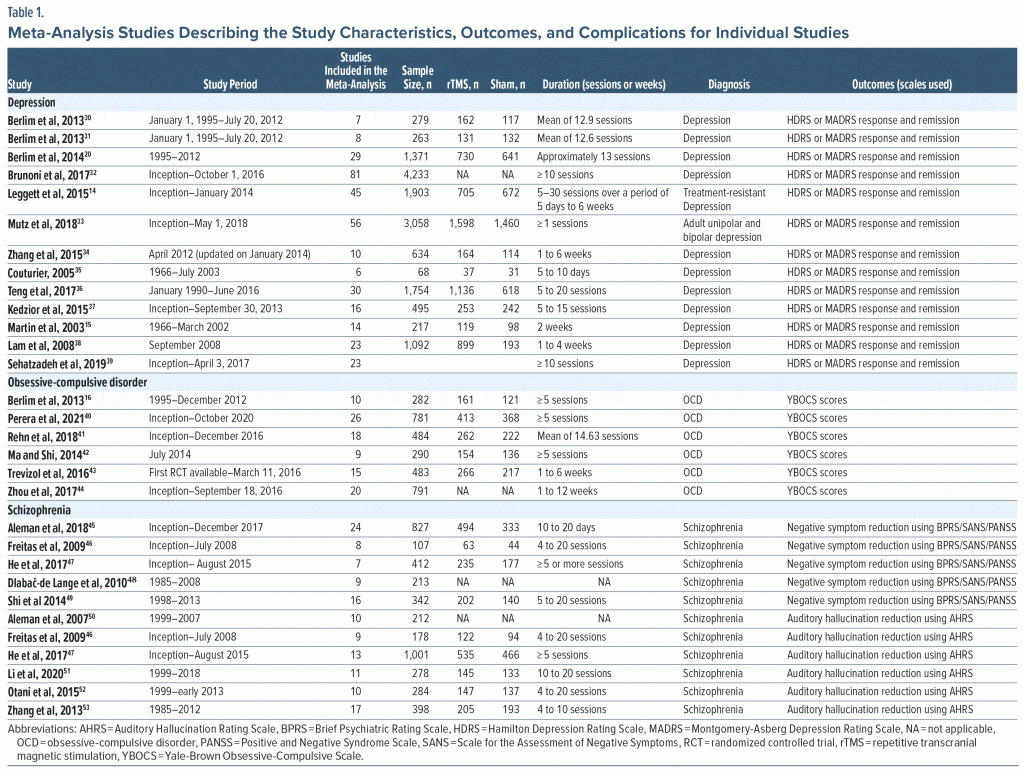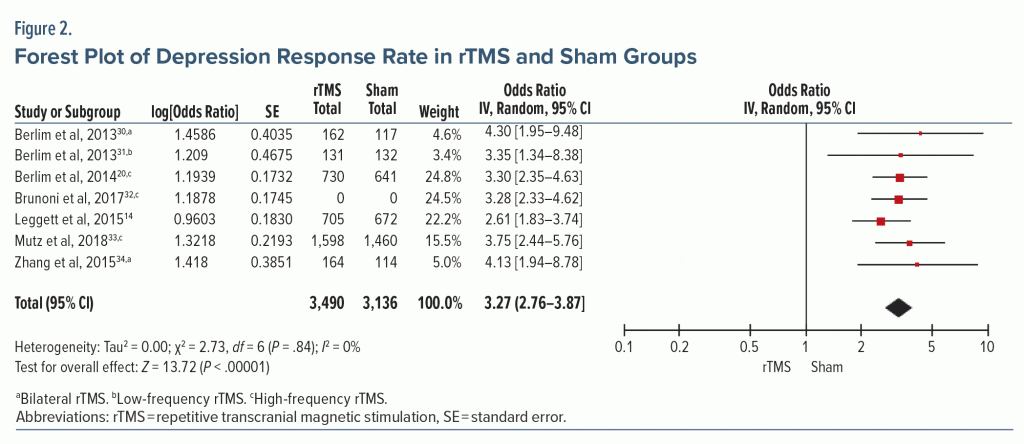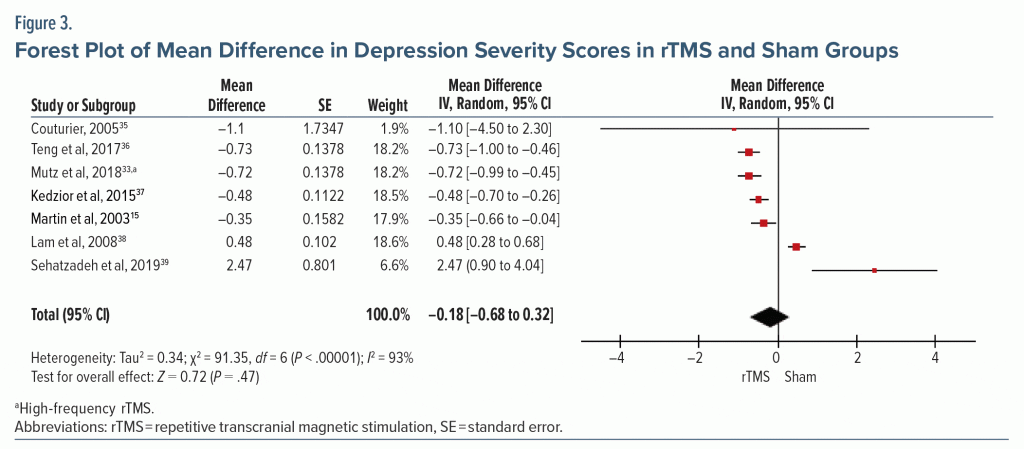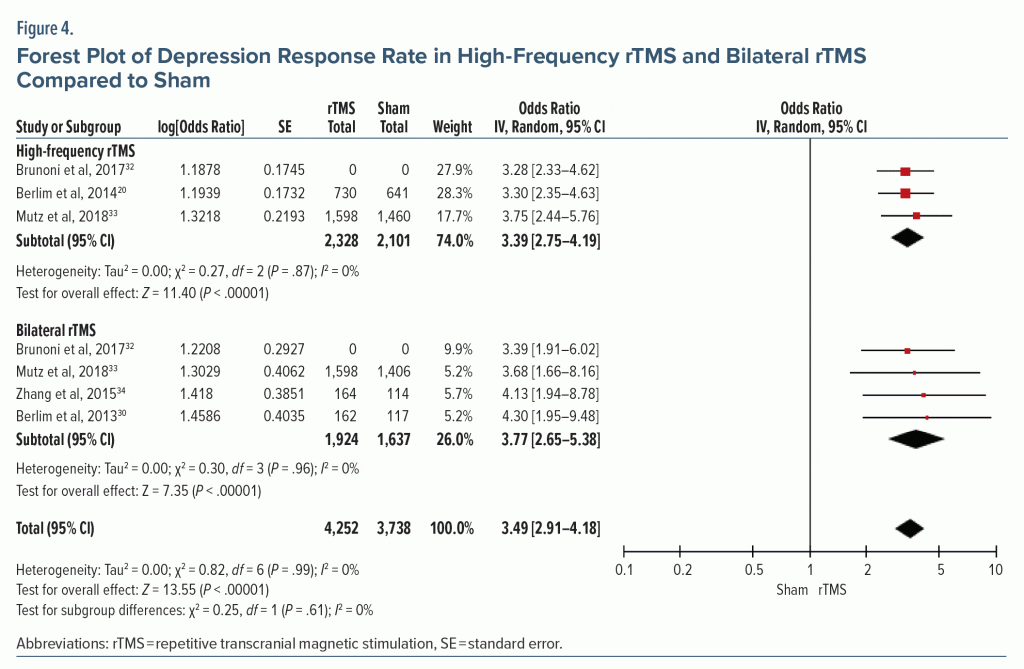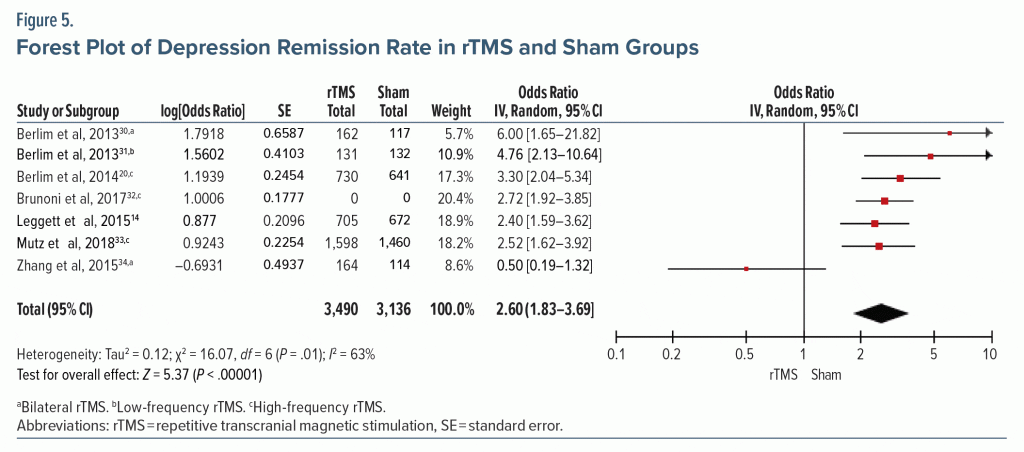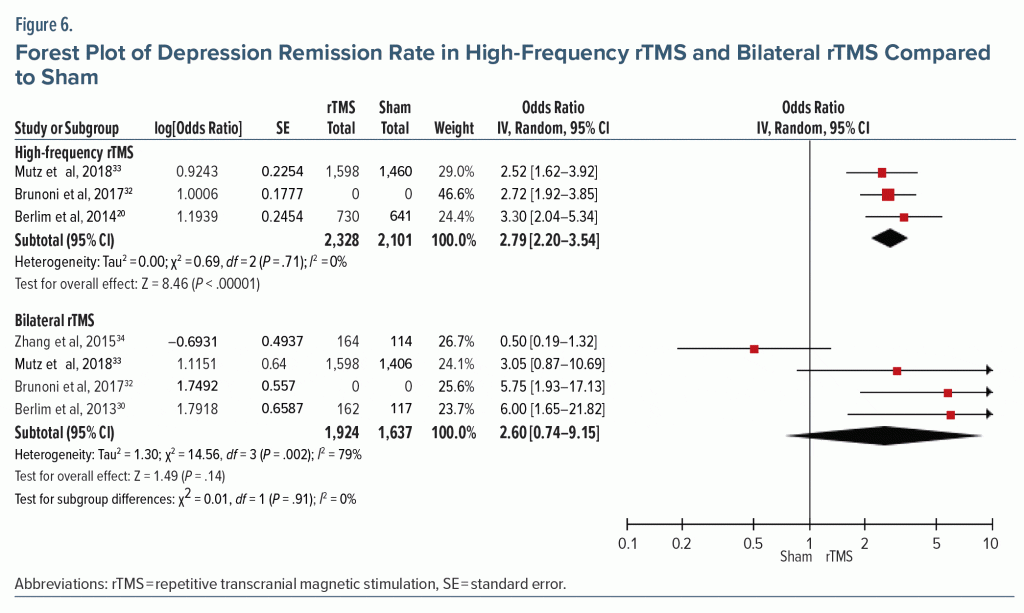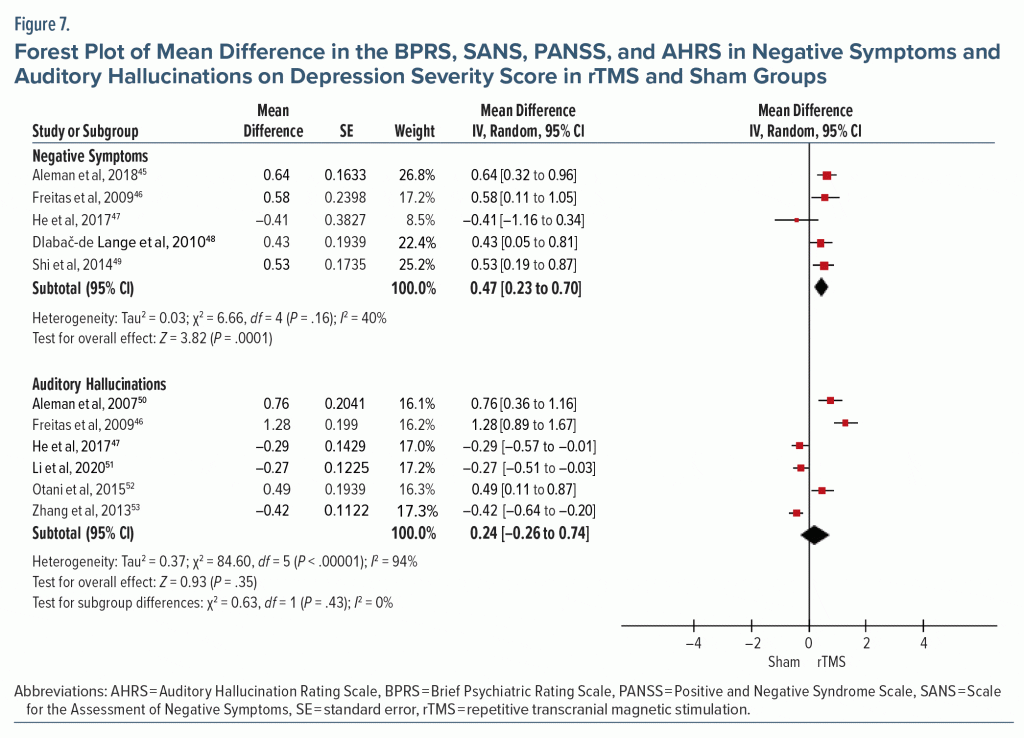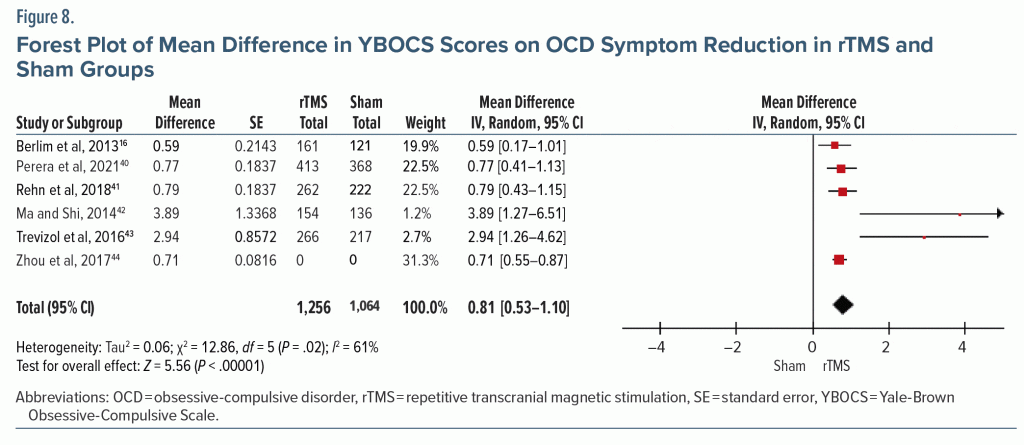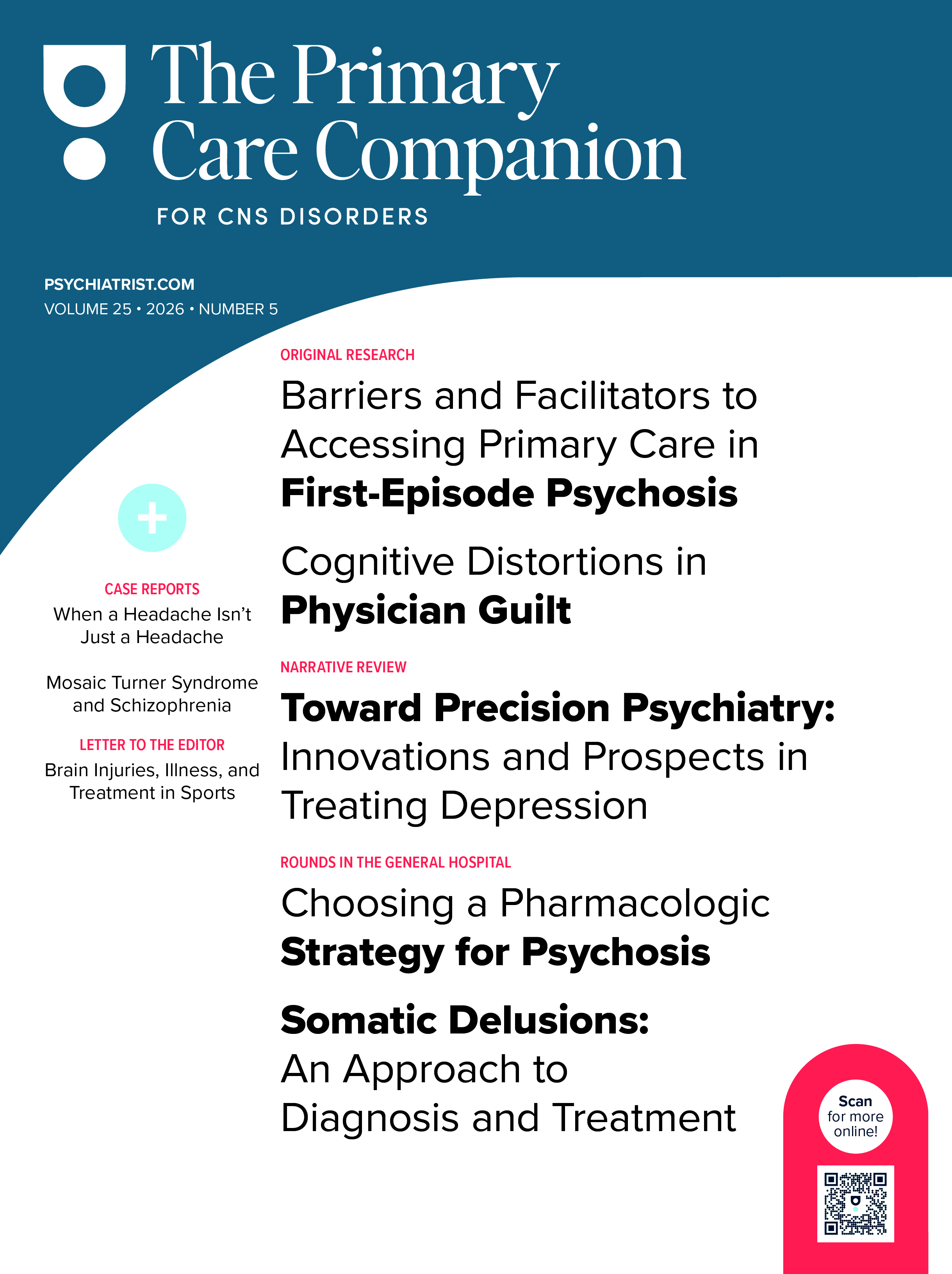ABSTRACT
Objective: To analyze the safety and efficacy of repetitive transcranial magnetic stimulation (rTMS) for major depressive disorder, schizophrenia, and obsessive-compulsive disorder (OCD) via umbrella meta-analysis.
Data Sources: Meta-analysis studies were searched in PubMed from inception to May 2021 using the keywords anxiety, depression, ADHD, schizophrenia, mood disorder, OCD, psychiatric disorders, GAD, bipolar disorders, ASD, PTSD, transcranial magnetic stimulation, transcranial, magnetic, stimulation. PRISMA guidelines were followed.
Study Selection: Abstracts and full-length articles were reviewed for meta-analysis studies with data on the safety and efficacy of rTMS and sham and were collected for quantitative analysis. The full texts of all identified studies were independently screened and assessed to determine eligibility. Any disagreement was resolved through consensus.
Data Extraction: The descriptive variables extracted included the author names, study year, sample size, studies included in the meta-analysis, study period, and type of intervention.
Results: 28 meta-analyses were included; 13 were on treatment-resistant depression, 9 on schizophrenia, and 6 on OCD. In treatment-resistant depression, the rTMS group had higher odds of response compared to sham (odds ratio [OR] = 3.27; 95% CI, 2.76–3.87; P < .00001) and higher odds of remission (secondary outcome) (OR = 2.83; 95% CI, 2.33–3.45; P < .00001). rTMS was superior to sham in the reduction of negative symptoms of schizophrenia (mean difference [MD]: 0.47; 95% CI, 0.23–0.7; P < .0001). However, no significant difference was found between the effects of rTMS and sham on auditory hallucinations (MD: 0.24; 95% CI, 0.26–0.74; P = .35), which resulted in 94% heterogeneity. TMS was better than sham in reducing the severity of OCD symptoms (MD: 0.81; 95% CI, 0.53–1.10; P < .00001).
Conclusions: The effectiveness of rTMS for symptom reduction in various psychiatric disorders is associated with differences in neuropathology, disease-specific target site, and frequency of rTMS.
Prim Care Companion CNS Disord 2023;25(5):22r03423
Author affiliations are listed at the end of this article.
Transcranial magnetic stimulation (TMS) (also described as repetitive TMS [rTMS]) is a neuromodulation technique that was first indicated for depression but now has wider utility in a variety of mental health conditions. Numerous studies have been conducted on the use of TMS in a variety of conditions, and there are meta-analyses for each condition available as well that provide guidance on the effect size. With many meta-analyses at our disposal, a question remains about how to interpret these various combinations of individual studies. One of the statistical approaches that can be used to further understand the outcome of several studies is umbrella meta-analysis, which is an analysis of previously conducted meta-analyses. When the meta-analyses with overlapping studies are included in a new meta-analysis, the idea is that the overall impact of the individual effect sizes is already accounted for in the newly reported effect size.
According to the National Institutes of Health, 7.1% of the US population suffers from a diagnosis of major depressive disorder (MDD), among which 63.8% have a severe impairment. Of this population, it was identified that only 65% of patients seek professional medical help.1 Schizophrenia ranks among the top 15 causes of disability globally.2 Approximately 50% of those with obsessive-compulsive disorder (OCD) have a serious impairment.3 Although multiple treatment options are available for these psychiatric disorders, a few cases may be resistant to 1 or more treatments. In recent years, noninvasive brain stimulation (NIBS) has gained popularity when standard treatments such as medications and psychotherapy have not been effective.4–8 NIBS refers to a set of technologies and techniques that modulate the excitability of the brain via transcranial stimulation to alter brain activity from the surface of the head without introducing instruments inside the body.
Two major types of NIBS are TMS and transcranial direct current stimulation.9 TMS was developed in 1985, and it generates an electromagnetic field to induce an electric current in the brain.10,11 rTMS is a type of TMS that uses electromagnetic pulses in rapid succession, causing a long-lasting effect.12 The efficacy and safety of using these techniques have been studied in various disorders like anxiety, depression, attention-deficit/hyperactivity disorder (ADHD), migraine, addiction, bipolar disorder, schizophrenia, and others.9 Distinct frequencies of rTMS have different effects on the brain. Low-frequency rTMS has an inhibitory effect, while high-frequency rTMS has excitatory effects.13 Various clinical trials and meta-analyses have been conducted over the years to assess the safety and efficacy of rTMS for psychiatric disorders.14–18 In 2008, rTMS was approved by the US Food and Drug Administration (FDA) to treat MDD in patients who do not respond to at least 1 antidepressant medication in the current episode.19
For depression, it was shown that high-frequency rTMS has antidepressant properties when compared to sham rTMS; however, overall response and remission rates remain unclear.20 For OCD, systematic review of randomized controlled trials (RCTs) found insufficient data to draw any conclusions regarding efficacy of transmagnetic stimulation in the treatment of OCD.21 Hence, in this umbrella meta-analysis, also known as meta-meta-analysis, we aimed to evaluate the safety and efficacy of rTMS compared to sham treatment in treatment-resistant depression, OCD, and schizophrenia.
METHODS
Search Strategy and Selection Criteria
We followed PRISMA guidelines22 in conducting the systematic review of meta-analysis studies comparing the safety and efficacy of rTMS and sham. Meta-analysis studies were searched in PubMed from inception to May 2021. The following keywords were used: (“anxiety”[Title/Abstract] OR “depression”[Title/Abstract] OR “ADHD”[Title/Abstract] OR “schizophrenia”[Title/Abstract] OR “mood disorder”[Title/Abstract] OR “OCD”[Title/Abstract] OR “psychiatric disorders”[Title/Abstract] OR “GAD”[Title/Abstract] OR “bipolar disorders”[Title/Abstract] OR “ASD”[Title/Abstract] OR “PTSD”[Title/Abstract]) AND (“transcranial magnetic stimulation”[MeSH Terms] OR (“transcranial”[All Fields] AND “magnetic”[All Fields] AND “stimulation”[All Fields]) OR “transcranial magnetic stimulation”[All Fields]). Meta-analyses comparing the safety and efficacy of rTMS versus sham in adult psychiatric disorders, including treatment-resistant depression, OCD, and schizophrenia, were included.
Meta-analyses that used rTMS as augmentation treatment and compared different types of rTMS were excluded. For depression, studies mainly included RCTs comparing rTMS to sham with no other antidepressants given during the trials. Additionally, studies not in English, observational studies, and those in pediatrics were excluded. The primary outcome was a clinical response defined as a 50% reduction in symptoms on the Hamilton Depression Rating Scale (HDRS)23 or Montgomery-Asberg Depression Rating Scale (MADRS),24 and remission (scores within normal range) was the secondary outcome. Other response scales used were the Yale-Brown Obsessive-Compulsive Scale (YBOCS),25 Positive and Negative Syndrome Scale (PANSS),26 Scale for the Assessment of Negative Symptoms (SANS),27 Brief Psychiatric Rating Scale (BPRS),28 and Auditory Hallucination Rating Scale (AHRS).29 The flow diagram of the literature search and study selection process are provided in Figure 1.
Study Selection
We reviewed abstracts and full-length articles for meta-analysis studies with data on the safety and efficacy of rTMS and sham and collected them for quantitative analysis. All identified studies were independently screened (by S.P., S.S., F.R., Y-C.S.H.), and full texts were assessed to determine eligibility. Any disagreement was resolved through consensus (by T.P. and U.P.).
Data Extraction
Data were extracted (by S.P., S.S., F.R., and Y-C.S.H.). The descriptive variables extracted were author names, study year, sample size, studies included in the meta-analysis, study period, type of intervention, and various outcomes as described in Table 1.
Statistical Analysis
Review Manager version 5.3 software was used for analysis. We performed a random effects model irrespective of heterogeneity to estimate the pooled effect size (odds ratio and risk difference) and their respective 95% CI. I2 values of 25%, 50%, and 75% represented low, medium, and high heterogeneity, respectively; P < .05 was considered statistically significant. The Newcastle-Ottawa Scale54 was used to estimate the risk of bias among studies. Outlier studies were identified using funnel plot during sensitivity analysis, and leave-one-out method was used.
RESULTS
A total of 128 records were screened. Of these records, 35 articles were eligible after applying the inclusion and exclusion criteria. After the second round of data collection, 7 more studies were excluded due to incomplete/missing information. As of May 10, 2021, 28 meta-analysis studies were included for qualitative and quantitative analysis (Figure 1). Of these 28 studies, 13 meta-analyses were on treatment-resistant depression, 6 on OCD, and 9 on schizophrenia (negative symptoms and positive symptoms as measured by auditory hallucinations).
Depression
rTMS response. Seven meta-analysis studies reported their overall effect of response as an odds ratio (OR). In the meta-meta-analysis, we found that the rTMS group has higher odds of response compared to the sham group (OR = 3.27; 95% CI, 2.76–3.87; P < .00001) with 0% heterogeneity (P = .84, I2: 0%) (Figure 2). However, a meta-analysis of 7 studies that reported the effectiveness of rTMS on the response scale found no statistical significance between rTMS and the sham group (mean difference [MD]: −0.18; 95% CI, −0.68–0.32; P = .47) with 93% heterogeneity (P < .00001) (Figure 3). To account for heterogeneity, we conducted a sensitivity analysis by removing 2 outlying studies: Sehatzadeh et al39 and Lam et al.38 Results after sensitivity analysis showed significant overall effect on reduction in depression severity scores in the rTMS group compared to the sham group (MD: −0.57; 95% CI, −0.73 to −0.42; P < .00001) with 23% heterogeneity (P = .27).
Subgroup analysis. In our subgroup analysis, 3 studies reported response outcomes using high-frequency rTMS and found that the high-frequency rTMS group had a higher response compared to the sham group in treatment-resistant depression (OR = 3.39; 95% CI, 2.75–4.19; P < .00001) with 0% heterogeneity (P = .87) (Figure 4). Furthermore, 5 meta-analyses found that bilateral rTMS had increased response compared to sham (OR = 3.77; 95% CI, 2.65–5.38; P < .00001) with 0% heterogeneity (P = .96, I2: 0%) (Figure 4).
rTMS remission. Seven meta-analyses had remission as a secondary outcome. Our analysis found that the rTMS group had increased remission compared to the sham group (OR = 2.60; 95% CI, 1.83–3.69; P < .00001) with 63% heterogeneity (P = .01, I2: 63%) (Figure 5). Sensitivity analysis was performed by removing one outlying study by Zhang et al.34 Results after sensitivity analysis also showed significant remission in the rTMS group compared to the sham group (OR = 2.83; 95% CI, 2.33–3.45; P < .00001) with 0% heterogeneity (P = .52).
Subgroup analysis. In this subgroup analysis, 3 meta-analyses that reported remission data revealed the high-frequency rTMS subgroup had higher remission compared to the sham group in treatment-resistant depression (OR = 2.79; 95% CI, 2.20–3.54; P < .00001) with 0% heterogeneity (P = .71) (Figure 6). Furthermore, 4 meta-analyses found no significant effect between the 2 groups on remission (OR = 2.60; 95% CI, 0.74–9.15; P = .14) with 79% heterogeneity (P = .002) (Figure 6). We performed sensitivity analysis on a bilateral rTMS subgroup by removing the outlying study by Zhang et al.34 Results after sensitivity analysis showed significant remission in the rTMS group compared to the sham group (OR = 4.79; 95% CI, 2.39–9.60; P < .00001) with 0% heterogeneity (P = .70).
Schizophrenia
Our meta-meta-analysis included 5 studies that reported effectiveness as the mean difference of rTMS on negative symptoms. We found that rTMS was superior compared to sham TMS in reduction of negative symptoms (MD: 0.47; 95% CI, 0.23–0.70; P = .0001) with 40% heterogeneity (P = .16, I2: 40%). A meta-meta-analysis of 6 meta-analyses showed no statistically significant difference between the effectiveness of rTMS and sham on auditory hallucinations (MD: 0.24; 95% CI, −0.26 to 0.74; P = .35) with 94% heterogeneity (P < .00001, I2: 94%) (Figure 7). All negative symptoms were included, whereas positive symptoms were measured by the effect of rTMS on auditory hallucinations.
OCD
In our meta-meta-analysis, we analyzed the data from 6 meta-analyses that reported a reduction in OCD symptoms using YBOCS scores and found that rTMS was superior to sham TMS in reducing the severity of OCD symptoms (MD: 0.81; 95% CI, 0.53–1.10; P < .00001) with 61% heterogeneity (P = .02, I2: 61%) (Figure 8).
DISCUSSION
The results of our meta-meta-analysis demonstrate that rTMS was more effective for treatment-resistant depression, as well as for reducing negative symptoms and auditory hallucinations in schizophrenia and OCD symptoms compared to sham treatment. In the subgroup analysis of treatment-resistant depression, we also found that high-frequency rTMS and bilateral rTMS compared to sham showed increased efficacy in clinical response and remission rates. Depending on the frequency of rTMS, it could either activate or inhibit the targeted brain region.55 For example, high-frequency rTMS has been shown to increase cerebral blood flow in targeted brain regions, whereas low-frequency rTMS reduces cerebral blood flow in targeted brain regions.56
In our meta-meta-analysis, a response is defined as a 50% reduction of HDRS or MADRS scores, and remission is defined as scores within the normal limits on the HDRS or MADRS. Our results suggest that rTMS is more effective in achieving a response (OR = 3.27) and remission (OR = 2.60) in treatment-resistant depression than sham rTMS. A study57 found that rTMS can be helpful in treatment-resistant depression by changing the metabolism in different parts of the brain. Concerto et al58 suggest that the efficacy and duration of rTMS can be based on its ability to change the excitability of the cerebral cortex and mood regulatory areas based on the frequency of rTMS. The authors58 also found that high-frequency rTMS was superior to sham in producing long-lasting antidepressant effects. We also found bilateral and high-frequency rTMS to be more effective in treatment-resistant depression. An RCT with 74 subjects by Blumberger et al59 reported bilateral rTMS was more effective in treatment-resistant depression. All the included studies show rTMS to be safe and well tolerated (Table 1). More studies are required to know the exact duration of the effect of rTMS.
rTMS over the dorsolateral prefrontal cortex (DLPFC) causes changes in functional connectivity between the anterior cingulate cortex (ACC) and frontoparietal neuronal circuits.60 It is believed that rTMS achieves these changes in brain connectivity by inducing neuroplastic changes such as long-term potentiation mediated by N-methyl-d-aspartate glutamate receptors.61 rTMS also promotes neurogenesis in brain regions such as the hippocampus by activating brain-derived neurotropic factor/tropomyosin receptor kinase B pathways.62 Previous studies63 have shown that depression is associated with impaired neurogenesis in the hippocampus. Thus, rTMS-induced changes in functional connectivity between critical brain regions involved in regulation of mood and cognition and neurogenesis in the hippocampus might explain the potential benefits of rTMS in reducing depressive symptoms.
In our meta-meta-analysis, we found that rTMS was superior to sham TMS in the reduction of negative symptoms (MD: 0.47, P = .0001); we found no statistically significant difference between the effects of rTMS and sham TMS on positive symptoms as measured by auditory hallucinations (MD: 0.24, P = .35). A systematic review and meta-analysis by Kennedy et al64 of 30 RCTs on rTMS (involving 768 participants) demonstrated that compared to sham, rTMS improved hallucinations and negative symptoms but was associated with modest, nonsignificant worsening of positive symptoms. The study64 also revealed that higher pulse frequency (> 10 Hz), motor threshold intensity of 110%, left prefrontal cortical treatment site, and trial duration over 3 weeks were associated with improvement in negative symptoms and worsening in positive symptoms (all P < .03). The symptom dimensions in schizophrenia may respond differently to brain stimulation interventions. A study by Stanford et al65 demonstrated that rTMS produces targeted changes in neurophysiologic measures in some brain regions, which can be the reason for its efficacy. Factors such as sex, patient subtype, pathophysiology (eg, confidence interval, electroencephalogram), accurate anatomic and functional coil localization, dose of rTMS, and duration of treatment may all affect the reduction in negative symptoms with rTMS.65
Negative symptoms of schizophrenia are largely believed to be hypo-functioning of prefrontal cortical brain regions, which are also attributed to executive dysfunction seen in schizophrenia.66 The functional magnetic resonance imaging (fMRI) evidence suggests that treatment with rTMS targeting the prefrontal cortex in schizophrenia patients results in an increase in task-specific activation of these brain regions, correlating with a reduction in negative symptoms.67
Our meta-meta-analysis results demonstrate that rTMS is a more effective treatment compared to sham TMS for OCD symptoms (MD: 0.81; 95% CI, 0.53–1.10; P < .00001). Heterogeneity for our results was 61% (P = .02, I2: 61%). A study by Tandt et al68 found that twice-daily low-frequency rTMS targeting dorsomedial prefrontal cortex in treatment-resistant OCD significantly decreased YBOCS scores (Z = −3.061, P = .002) in 12 patients after 10 days of treatment. Rostami et al69 found that patients who were treatment resistant and had low scores in the obsession severity, disturbance, and resistance factors of the YBOCS might benefit more from rTMS.
The ability of rTMS to alter functional connectivity between brain regions could also explain the benefits of rTMS in reducing obsessive-compulsive symptoms. Unmedicated individuals with OCD show abnormally high connectivity between the orbitofrontal cortex and putamen.70 Unlike depression, DLPFC may not be an ideal target for treating OCD, as rTMS-induced neuronal firing in this brain region has been shown to induce obsessive-compulsive symptoms.71 rTMS, especially in low frequency, targeting primary motor and orbitofrontal areas has been most promising in reducing OCD symptoms.72 The fMRI studies have shown a reduction in cortico-striatal hyperconnectivity seen in OCD following rTMS, which correlated to a decrease in YBOCS scores.73
Advantages and Disadvantages of rTMS
The most common side effects of rTMS during treatment are transient head or scalp discomfort and skin redness at or around the location where TMS pulses are applied. The patient may experience discomfort and twitching or movement of adjacent areas of the face, ipsilateral eye, ear, nose, and jaw during stimulation trains due to excitation of superficial nerve branches and contraction of superficial muscle groups.74 Headache is another common side effect, but procedural pain and headache typically decrease due to habituation or the direct antinociceptive effect of TMS.75 Seizures (ie, the most serious TMS-related acute adverse effect) have been extremely rare, with most of the few new cases receiving rTMS exceeding previous guidelines, often in patients under treatment with drugs that potentially lower the seizure threshold.76 An uncommon side effect of rTMS is the induction of mania or hypomania.77
Future Directions of TMS
Intermittent theta-burst stimulation (iTBS), which can be conceptualized as a second-generation form of TMS, allows an entire therapeutic “dose” equivalent of stimulation to be delivered in 3–10 minutes, a fraction of the time required for standard TMS.78 Stanford Accelerated Intelligent Neuromodulation Therapy is an accelerated, high-dose resting-state functional connectivity MRI–guided iTBS protocol for treatment-resistant depression. The treatment produced very high levels of clinical remission, exceeding those observed in more traditional TMS studies, and the majority of the remissions occurred in the first 3 days of a 5-day course of treatment.79 In 2018, the FDA approved a new TMS device called sTMS that delivers a single pulse to the brain of those suffering from frequent debilitating migraines, and researchers found that sTMS helped reduce the days people had headaches by one-third.80,81
Limitations and Strengths
Meta-analyses can be poorly conducted; abstracting and summarizing large sets of data points can lead to inappropriate conclusions, failing to consider variation in data. Bias from the analysts, overgeneralizations, and overarching statements that lack precision could be some of the overall issues. The heterogeneity of the studies, the possible inclusion of noncomparable variables, and the omission of some of the subtle conclusions of individual studies are other issues. All these limitations, to some extent, apply to our analysis as well; however, we have attempted to be accurate in abstracting and summarizing. The strengths of meta-analyses lie with increased sample size and thus greater power of the integrated data. This approach allows one to summarize and quantify results and conclusions from numerous individual studies. We found meta-analysis studies only on depression, schizophrenia, and OCD that were analyzable from the umbrella meta-analysis perspective.
CONCLUSION
The results of the meta-meta-analysis revealed that rTMS exerts its effects by altering functional connectivity between brain regions by activating or inhibiting the targeted brain region depending on the frequency of rTMS used. Since different mental illnesses are associated with differences in neuropathology, disease-specific target site and frequency of rTMS are 2 of the most important parameters related to the efficacy of rTMS in symptom reduction in various psychiatric disorders. Future studies that lead the field toward more individualized and personalized treatment guided by objective parameters such as imaging would add to the existing knowledge base.
Article Information
Published Online: September 26, 2023. https://doi.org/10.4088/PCC.22r03423
© 2023 Physicians Postgraduate Press, Inc.
Submitted: September 26, 2022; accepted March 3, 2023.
To Cite: Patel S, Silvi S, Desai S, et al. Effectiveness of repetitive transcranial magnetic stimulation in depression, schizophrenia, and obsessive-compulsive disorder: an umbrella meta-analysis. Prim Care Companion CNS Disord. 2023;25(5):22r03423.
Author Affiliations: Department of Epidemiology, New York University, New York (S. Patel); Department of Psychiatry, Millwood Hospital, Arlington, Texas (Silvi); Department of Psychiatry, Tower Health/Phoenixville Hospital, Phoenixville, Pennsylvania (Desai); Karuna Medical College, Palakkad, Kerala, India (Rahman); St. George’s University School of Medicine, St. George’s, Grenada, West Indies (Depa); Department of Child and Adolescent Psychiatry, Tulane University School of Medicine, New Orleans, Louisiana (Hanif); Department of Child and Adolescent Psychiatry, BronxCare Health System, New York (Rizvi); Department of Public Health, Icahn School of Medicine at Mount Sinai, New York (Hsieh); Department of Pathology, Montefiore Medical Center, New York (Malik); Department of Public Health, Icahn School of Medicine at Mount Sinai, New York (U. Patel); Department of Psychiatry, Boston Children’s Hospital/Harvard Medical School, Massachusetts (Mansuri); Department of Psychiatry, Indiana University Health Ball Memorial Hospital, Muncie (Pathrose); Department of Psychiatry, Unitypoint Health, Peoria, Illinois (Aedma); Department of Psychiatry, Northwestern University Feinberg School of Medicine, Chicago, Illinois (Parikh).
Corresponding Author: Saral Desai, MD, Department of Psychiatry, Tower Health/Phoenixville Hospital, 140 Nutt Rd, Phoenixville, PA 19460 ([email protected]).
Author Contributions: Drs S. Patel and Silvi are equally contributing first authors.
Relevant Financial Relationships: None.
Funding/Support: None.
Additional Information: The data collected from the studies are published online and publicly available. Specific details related to data or analysis are available from the corresponding author upon request.
Clinical Points
- In treatment-resistant depression, repetitive transcranial magnetic stimulation (rTMS) had higher odds of response and remission rates compared to sham.
- In schizophrenia, rTMS was superior to sham in the reduction of negative symptoms, but no significant difference was found between the effects of rTMS and sham on auditory hallucinations (ie, positive symptoms).
- rTMS was better than sham in reducing the severity of obsessive-compulsive disorder symptoms.
References (81)

- National Institute of Mental Health. Major depression. Accessed August 24, 2021. https://www.nimh.nih.gov/health/statistics/major-depression
- National Institute of Mental Health. Schizophrenia. Accessed August 24, 2021. https://www.nimh.nih.gov/health/statistics/schizophrenia#part_154880
- National Institute of Mental Health. Obsessive-compulsive disorder. Accessed August 24, 2021. https://www.nimh.nih.gov/health/statistics/obsessive-compulsive-disorder-ocd
- Buchanan DM, Robaey P, D’Angiulli A. What do we know about transcranial direct current stimulation for major depression? Brain Sci. 2020;10(8):480. PubMed CrossRef
- Moffa AH, Brunoni AR, Nikolin S, et al. Transcranial direct current stimulation in psychiatric disorders: a comprehensive review. Psychiatr Clin North Am. 2018;41(3):447–463. PubMed CrossRef
- Haller N, Hasan A, Padberg F, et al. Transkranielle elektrische Hirnstimulationsverfahren zur Behandlung der Negativsymptomatik bei Schizophrenie. (Transcranial electrical brain stimulation methods for treatment of negative symptoms in schizophrenia). Nervenarzt. 2022;93(1):41–50. PubMed CrossRef
- Dunlop K, Hanlon CA, Downar J. Noninvasive brain stimulation treatments for addiction and major depression. Ann N Y Acad Sci. 2017;1394(1):31–54. PubMed CrossRef
- Trojak B, Sauvaget A, Fecteau S, et al. Outcome of non-invasive brain stimulation in substance use disorders: a review of randomized sham-controlled clinical trials. J Neuropsychiatry Clin Neurosci. 2017;29(2):105–118. PubMed CrossRef
- Boes AD, Kelly MS, Trapp NT, et al. Noninvasive brain stimulation: challenges and opportunities for a new clinical specialty. J Neuropsychiatry Clin Neurosci. 2018;30(3):173–179. PubMed CrossRef
- Barker AT, Jalinous R, Freeston IL. Non-invasive magnetic stimulation of human motor cortex. Lancet. 1985;325(8437):1106–1107. PubMed CrossRef
- Wagner T, Valero-Cabre A, Pascual-Leone A. Noninvasive human brain stimulation. Annu Rev Biomed Eng. 2007;9(1):527–565. PubMed CrossRef
- Maeda F, Keenan JP, Tormos JM, et al. Modulation of corticospinal excitability by repetitive transcranial magnetic stimulation. Clin Neurophysiol. 2000;111(5):800–805. PubMed CrossRef
- Klomjai W, Katz R, Lackmy-Vallée A. Basic principles of transcranial magnetic stimulation (TMS) and repetitive TMS (rTMS). Ann Phys Rehabil Med. 2015;58(4):208–213. PubMed CrossRef
- Leggett LE, Soril LJJ, Coward S, et al. Repetitive transcranial magnetic stimulation for treatment-resistant depression in adult and youth populations: a systematic literature review and meta-analysis. Prim Care Companion CNS Disord. 2015;17(6):15r01807. PubMed CrossRef
- Martin JLR, Barbanoj MJ, Schlaepfer TE, et al. Repetitive transcranial magnetic stimulation for the treatment of depression: systematic review and meta-analysis. Br J Psychiatry. 2003;182(6):480–491. PubMed CrossRef
- Berlim MT, Neufeld NH, Van den Eynde F. Repetitive transcranial magnetic stimulation (rTMS) for obsessive-compulsive disorder (OCD): an exploratory meta-analysis of randomized and sham-controlled trials. J Psychiatr Res. 2013;47(8):999–1006. PubMed CrossRef
- Yesavage JA, Fairchild JK, Mi Z, et al. VA Cooperative Studies Program Study Team. Effect of repetitive transcranial magnetic stimulation on treatment-resistant major depression in us veterans: a randomized clinical trial. JAMA Psychiatry. 2018;75(9):884–893. PubMed CrossRef
- Haghighi M, Shayganfard M, Jahangard L, et al. Repetitive transcranial magnetic stimulation (rTMS) improves symptoms and reduces clinical illness in patients suffering from OCD: results from a single-blind, randomized clinical trial with sham cross-over condition. J Psychiatr Res. 2015;68:238–244. PubMed CrossRef
- National Institute of Mental Health. Brain stimulation therapies. Accessed August 24, 2021. https://www.nimh.nih.gov
- Berlim MT, van den Eynde F, Tovar-Perdomo S, et al. Response, remission and drop-out rates following high-frequency repetitive transcranial magnetic stimulation (rTMS) for treating major depression: a systematic review and meta-analysis of randomized, double-blind and sham-controlled trials. Psychol Med. 2014;44(2):225–239. PubMed CrossRef
- Martin JL, Barbanoj MJ, Pérez V, et al. Transcranial magnetic stimulation for the treatment of obsessive-compulsive disorder. Cochrane Database Syst Rev. 2003;2003(3):CD003387. PubMed CrossRef
- Page MJ, McKenzie JE, Bossuyt PM, et al. The PRISMA 2020 statement: an updated guideline for reporting systematic reviews. BMJ. 2021;372(71):n71. PubMed CrossRef
- Hamilton M. A rating scale for depression. J Neurol Neurosurg Psychiatry. 1960;23(1):56–62. PubMed CrossRef
- Montgomery SA, Asberg M. A new depression scale designed to be sensitive to change. Br J Psychiatry. 1979;134(4):382–389. PubMed CrossRef
- Goodman WK, Price LH, Rasmussen SA, et al. The Yale-Brown Obsessive Compulsive Scale, I: development, use, and reliability. Arch Gen Psychiatry. 1989;46(11):1006–1011. PubMed CrossRef
- Kay SR, Fiszbein A, Opler LA. The Positive and Negative Syndrome Scale (PANSS) for schizophrenia. Schizophr Bull. 1987;13(2):261–276. PubMed CrossRef
- Andreasen NC. Negative symptoms in schizophrenia: definition and reliability. Arch Gen Psychiatry. 1982;39(7):784–788. PubMed CrossRef
- Overall JE. The Brief Psychiatric Rating Scale (BPRS): recent developments in ascertainment and scaling. Psychopharmacol Bull. 1988;24:97–100.
- Hoffman RE, Gueorguieva R, Hawkins KA, et al. Temporoparietal transcranial magnetic stimulation for auditory hallucinations: safety, efficacy and moderators in a 50-patient sample. Biol Psychiatry. 2005;58(2):97–104. PubMed CrossRef
- Berlim MT, Van den Eynde F, Daskalakis ZJ. A systematic review and meta-analysis on the efficacy and acceptability of bilateral repetitive transcranial magnetic stimulation (rTMS) for treating major depression. Psychol Med. 2013;43(11):2245–2254. PubMed CrossRef
- Berlim MT, Van den Eynde F, Jeff Daskalakis Z. Clinically meaningful efficacy and acceptability of low-frequency repetitive transcranial magnetic stimulation (rTMS) for treating primary major depression: a meta-analysis of randomized, double-blind and sham-controlled trials. Neuropsychopharmacology. 2013;38(4):543–551. PubMed CrossRef
- Brunoni AR, Chaimani A, Moffa AH, et al. Repetitive transcranial magnetic stimulation for the acute treatment of major depressive episodes: a systematic review with network meta-analysis. JAMA Psychiatry. 2017;74(2):143–152. PubMed CrossRef
- Mutz J, Edgcumbe DR, Brunoni AR, et al. Efficacy and acceptability of non-invasive brain stimulation for the treatment of adult unipolar and bipolar depression: a systematic review and meta-analysis of randomised sham-controlled trials. Neurosci Biobehav Rev. 2018;92:291–303. PubMed CrossRef
- Zhang YQ, Zhu D, Zhou XY, et al. Bilateral repetitive transcranial magnetic stimulation for treatment-resistant depression: a systematic review and meta-analysis of randomized controlled trials. Braz J Med Biol Res. 2015;48(3):198–206. PubMed CrossRef
- Couturier JL. Efficacy of rapid-rate repetitive transcranial magnetic stimulation in the treatment of depression: a systematic review and meta-analysis. J Psychiatry Neurosci. 2005;30(2):83–90. PubMed
- Teng S, Guo Z, Peng H, et al. High-frequency repetitive transcranial magnetic stimulation over the left DLPFC for major depression: session-dependent efficacy: a meta-analysis. Eur Psychiatry. 2017;41(1):75–84. PubMed CrossRef
- Kedzior KK, Reitz SK, Azorina V, et al. Durability of the antidepressant effect of the high-frequency repetitive transcranial magnetic stimulation (rTMS) in the absence of maintenance treatment in major depression: a systematic review and meta-analysis of 16 double-blind, randomized, sham-controlled trials. Depress Anxiety. 2015;32(3):193–203. PubMed CrossRef
- Lam RW, Chan P, Wilkins-Ho M, et al. Repetitive transcranial magnetic stimulation for treatment-resistant depression: a systematic review and meta-analysis. Can J Psychiatry. 2008;53(9):621–631. PubMed CrossRef
- Sehatzadeh S, Daskalakis ZJ, Yap B, et al. Unilateral and bilateral repetitive transcranial magnetic stimulation for treatment-resistant depression: a meta-analysis of randomized controlled trials over 2 decades. J Psychiatry Neurosci. 2019;44(3):151–163. PubMed CrossRef
- Perera MPN, Mallawaarachchi S, Miljevic A, et al. Repetitive transcranial magnetic stimulation for obsessive-compulsive disorder: a meta-analysis of randomized, sham-controlled trials. Biol Psychiatry Cogn Neurosci Neuroimaging. 2021;6(10):947–960. PubMed CrossRef
- Rehn S, Eslick GD, Brakoulias V. A meta-analysis of the effectiveness of different cortical targets used in repetitive transcranial magnetic stimulation (rTMS) for the treatment of obsessive-compulsive disorder (OCD). Psychiatr Q. 2018;89(3):645–665. PubMed CrossRef
- Ma Z-R, Shi L-J. Repetitive transcranial magnetic stimulation (rTMS) augmentation of selective serotonin reuptake inhibitors (SSRIs) for SSRI-resistant obsessive-compulsive disorder (OCD): a meta-analysis of randomized controlled trials. Int J Clin Exp Med. 2014;7(12):4897–4905. PubMed
- Trevizol AP, Shiozawa P, Cook IA, et al. Transcranial magnetic stimulation for obsessive-compulsive disorder: an updated systematic review and meta-analysis. J ECT. 2016;32(4):262–266. PubMed CrossRef
- Zhou DD, Wang W, Wang GM, et al. An updated meta-analysis: short-term therapeutic effects of repeated transcranial magnetic stimulation in treating obsessive-compulsive disorder. J Affect Disord. 2017;215:187–196. PubMed CrossRef
- Aleman A, Enriquez-Geppert S, Knegtering H, et al. Moderate effects of noninvasive brain stimulation of the frontal cortex for improving negative symptoms in schizophrenia: meta-analysis of controlled trials. Neurosci Biobehav Rev. 2018;89:111–118. PubMed CrossRef
- Freitas C, Fregni F, Pascual-Leone A. Meta-analysis of the effects of repetitive transcranial magnetic stimulation (rTMS) on negative and positive symptoms in schizophrenia. Schizophr Res. 2009;108(1–3):11–24. PubMed CrossRef
- He H, Lu J, Yang L, et al. Repetitive transcranial magnetic stimulation for treating the symptoms of schizophrenia: a PRISMA-compliant meta-analysis. Clin Neurophysiol. 2017;128(5):716–724. PubMed CrossRef
- Dlabač-de Lange JJ, Knegtering R, Aleman A. Repetitive transcranial magnetic stimulation for negative symptoms of schizophrenia: review and meta-analysis. J Clin Psychiatry. 2010;71(4):411–418. PubMed CrossRef
- Shi C, Yu X, Cheung EFC, et al. Revisiting the therapeutic effect of rTMS on negative symptoms in schizophrenia: a meta-analysis. Psychiatry Res. 2014;215(3):505–513. PubMed CrossRef
- Aleman A, Sommer IE, Kahn RS. Efficacy of slow repetitive transcranial magnetic stimulation in the treatment of resistant auditory hallucinations in schizophrenia: a meta-analysis. J Clin Psychiatry. 2007;68(3):416–421. PubMed CrossRef
- Li J, Cao X, Liu S, et al. Efficacy of repetitive transcranial magnetic stimulation on auditory hallucinations in schizophrenia: a meta-analysis. Psychiatry Res. 2020;290:113141. PubMed CrossRef
- Otani VHO, Shiozawa P, Cordeiro Q, et al. A systematic review and meta-analysis of the use of repetitive transcranial magnetic stimulation for auditory hallucinations treatment in refractory schizophrenic patients. Int J Psychiatry Clin Pract. 2015;19(4):228–232. PubMed CrossRef
- Zhang Y, Liang W, Yang S, et al. Repetitive transcranial magnetic stimulation for hallucination in schizophrenia spectrum disorders: a meta-analysis. Neural Regen Res. 2013;8(28):2666–2676. PubMed.
- Wells GA, Shea B, O'Connell D, et al. The Newcastle-Ottawa Scale (NOS) for assessing the quality of nonrandomized studies in meta-analyses. Accessed August 24, 2021. https://www.ohri.ca/programs/clinical_epidemiology/oxford.asp
- Baeken C, De Raedt R. Neurobiological mechanisms of repetitive transcranial magnetic stimulation on the underlying neurocircuitry in unipolar depression. Dialogues Clin Neurosci. 2011;13(1):139–145. PubMed CrossRef
- Noda Y, Silverstein WK, Barr MS, et al. Neurobiological mechanisms of repetitive transcranial magnetic stimulation of the dorsolateral prefrontal cortex in depression: a systematic review. Psychol Med. 2015;45(16):3411–3432. PubMed CrossRef
- Paillère Martinot ML, Martinot J-L, Ringuenet D, et al. Baseline brain metabolism in resistant depression and response to transcranial magnetic stimulation. Neuropsychopharmacology. 2011;36(13):2710–2719. PubMed CrossRef
- Concerto C, Lanza G, Cantone M, et al. Repetitive transcranial magnetic stimulation in patients with drug-resistant major depression: a six-month clinical follow-up study. Int J Psychiatry Clin Pract. 2015;19(4):252–258. PubMed CrossRef
- Blumberger DM, Mulsant BH, Fitzgerald PB, et al. A randomized double-blind sham-controlled comparison of unilateral and bilateral repetitive transcranial magnetic stimulation for treatment-resistant major depression. World J Biol Psychiatry. 2012;13(6):423–435. PubMed CrossRef
- Tik M, Hoffmann A, Sladky R, et al. Towards understanding rTMS mechanism of action: stimulation of the DLPFC causes network-specific increase in functional connectivity. Neuroimage. 2017;162:289–296. PubMed CrossRef
- Brown JC, DeVries WH, Korte JE, et al. NMDA receptor partial agonist, d-cycloserine, enhances 10 Hz rTMS-induced motor plasticity, suggesting long-term potentiation (LTP) as underlying mechanism. Brain Stimul. 2020;13(3):530–532. PubMed CrossRef
- Shang Y, Wang X, Li F, et al. rTMS ameliorates prenatal stress-induced cognitive deficits in male-offspring rats associated with BDNF/TrkB signaling pathway. Neurorehabil Neural Repair. 2019;33(4):271–283. PubMed CrossRef
- Lim S-H, Shin S, Kim M-H, et al. Depression-like behaviors induced by defective PTPRT activity through dysregulated synaptic functions and neurogenesis. J Cell Sci. 2020;133(20):jcs.243972. PubMed CrossRef
- Kennedy NI, Lee WH, Frangou S. Efficacy of non-invasive brain stimulation on the symptom dimensions of schizophrenia: a meta-analysis of randomized controlled trials. Eur Psychiatry. 2018;49:69–77. PubMed CrossRef
- Stanford AD, Sharif Z, Corcoran C, et al. rTMS strategies for the study and treatment of schizophrenia: a review. Int J Neuropsychopharmacol. 2008;11(4):563–576. PubMed CrossRef
- Walton E, Hibar DP, van Erp TGM, et al. Karolinska Schizophrenia Project Consortium (KaSP). Prefrontal cortical thinning links to negative symptoms in schizophrenia via the ENIGMA consortium. Psychol Med. 2018;48(1):82–94. PubMed CrossRef
- Dlabac-de Lange JJ, Liemburg EJ, Bais L, et alD.L. JJ. Effect of rTMS on brain activation in schizophrenia with negative symptoms: a proof-of-principle study. Schizophr Res. 2015;168(1-2):475–482. PubMed CrossRef
- Tandt HLN, Van de Velde N, De Witte S, et al. Is twice daily LF-rTMS a viable treatment option for treatment-resistant OCD? Results from an open-label feasibility study. Eur Arch Psychiatry Clin Neurosci. 2021;271(1):211–214. PubMed CrossRef
- Rostami R, Kazemi R, Jabbari A, et al. Efficacy and clinical predictors of response to rTMS treatment in pharmacoresistant obsessive-compulsive disorder (OCD): a retrospective study. BMC Psychiatry. 2020;20(1):372. PubMed CrossRef
- Beucke JC, Sepulcre J, Talukdar T, et al. Abnormally high degree connectivity of the orbitofrontal cortex in obsessive-compulsive disorder. JAMA Psychiatry. 2013;70(6):619–629. PubMed CrossRef
- Garg H, Kumar S, Singh S, et al. New onset obsessive compulsive disorder following high frequency repetitive transcranial magnetic stimulation over left dorsolateral prefrontal cortex for treatment of negative symptoms in a patient with schizophrenia. Clin Psychopharmacol Neurosci. 2019;17(3):443–445. PubMed CrossRef
- Rapinesi C, Kotzalidis GD, Ferracuti S, et al. Brain stimulation in obsessive-compulsive disorder (OCD): a systematic review. Curr Neuropharmacol. 2019;17(8):787–807. PubMed CrossRef
- Dunlop K, Woodside B, Olmsted M, et al. Reductions in cortico-striatal hyperconnectivity accompany successful treatment of obsessive-compulsive disorder with dorsomedial prefrontal rTMS. Neuropsychopharmacology. 2016;41(5):1395–1403. PubMed CrossRef
- McClintock SM, Reti IM, Carpenter LL, et al. American Psychiatric Association Council on Research Task Force on Novel Biomarkers and Treatments. Consensus recommendations for the clinical application of repetitive transcranial magnetic stimulation (rTMS) in the treatment of depression. J Clin Psychiatry. 2018;79(1):35–48. PubMed CrossRef
- Taylor JJ, Borckardt JJ, George MS. Endogenous opioids mediate left dorsolateral prefrontal cortex rTMS-induced analgesia. Pain. 2012;153(6):1219–1225. PubMed CrossRef
- Rossi S, Hallett M, Rossini PM, et al. Safety of TMS Consensus Group. Safety, ethical considerations, and application guidelines for the use of transcranial magnetic stimulation in clinical practice and research. Clin Neurophysiol. 2009;120(12):2008–2039. PubMed CrossRef
- Dolberg OT, Schreiber S, Grunhaus L, et al. Transcranial magnetic stimulation-induced switch into mania: a report of two cases. Biol Psychiatry. 2001;49(5):468–470. PubMed CrossRef
- Carpenter LL, Philip NS. The future is now? rapid advances by brain stimulation innovation. Am J Psychiatry. 2020;177(8):654–656. PubMed CrossRef
- Cole EJ, Stimpson KH, Bentzley BS, et al. Stanford accelerated intelligent neuromodulation therapy for treatment-resistant depression. Am J Psychiatry. 2020;177(8):716–726. PubMed CrossRef
- FDA permits marketing of transcranial magnetic stimulation for treatment of obsessive-compulsive disorder. Accessed August 24, 2021. https://www.fda.gov/news-events/press-announcements/fda-permits-marketing-transcranial-magnetic-stimulation-treatment-obsessive-compulsive-disorder
- Jeffrey S. FDA approves first device to treat migraine pain. Accessed August 24, 2021. https://www.medscape.com/viewarticle/817831
Please sign in or purchase this PDF for $40.

